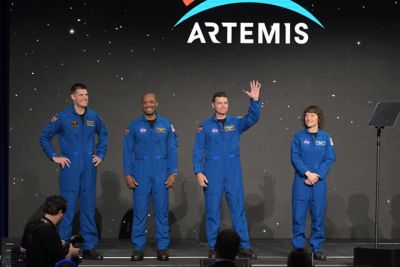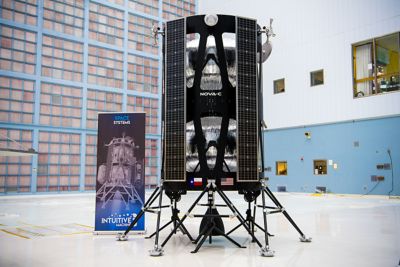-
-
Access Free Student Software
Ansys empowers the next generation of engineers
Students get free access to world-class simulation software.
-
Connect with Ansys Now!
Design your future
Connect with Ansys to explore how simulation can power your next breakthrough.
Countries & Regions
Free Trials
Products & Services
Learn
About
Back
Products & Services
Back
Learn
Ansys empowers the next generation of engineers
Students get free access to world-class simulation software.
Back
About
Design your future
Connect with Ansys to explore how simulation can power your next breakthrough.
Free Trials
ANSYS BLOG
June 9, 2023
To the Moon and Beyond
In November 2022, NASA made history when it launched its most powerful rocket ever produced, the Space Launch System, which carried the unmanned Orion capsule into the Moon’s orbit before it returned to Earth 25 days later. This groundbreaking event marked the first mission in the space agency’s ambitious Artemis lunar-exploration program, which aims to land humans on the Moon in 2025.
The Artemis program marks NASA’s first journey to the Moon with humans aboard in over 50 years, and many things have changed since the final Apollo mission in 1972. Today, NASA is not developing all the required space technologies on its own, but is instead partnering with a range of private companies — from giants like SpaceX to smaller startups like Astrobotic Technology, Intuitive Machines, and Firefly Aerospace (all part of the Ansys Startup Program) among others — to source critical components and execute missions.
According to NASA’s Johnson Space Center Director Vanessa Wyche, the concept of public-private collaboration is foundational to NASA’s mission of innovation and discovery today. “This mission paves the way for the expansion of human deep space exploration and presents new opportunities for scientific discoveries, commercial, industry, and academic partnerships and the Artemis Generation,” said Wyche in a press release.

From left: Canadian Space Agency astronaut Jeremy Hansen, and NASA astronauts Victor Glover, Reid Wiseman, and Christina Koch greet the crowd at Ellington Field near NASA’s Johnson Space Center on April 3, 2023. Image credit: NASA.
Small Companies Fuel NASA’s Success
Over the next two years, NASA will continue to send unmanned test flights to the Moon, as it demonstrates the capabilities of both the rocket and the space capsule to safely complete the nearly half-million-mile round trip. At the same time, NASA will also deliver supplies to the Moon’s surface as it performs science experiments, tests new field technologies, identifies a landing position, and builds an Artemis Base Camp in preparation for human missions.
Private companies, including a number of Ansys customers, are playing a leading role in delivering these supplies to the Moon. Engineering simulation is a key component of these companies’ efforts. It enables them to meet mission requirements as they develop components faster and less expensively than they could the old way, by building and testing multiple prototypes.
“Engineering simulation is purpose-built to design and validate products in a low-risk, low-cost virtual environment where physical testing is time-consuming, expensive, or simply not possible,” says James Woodburn, Ansys Fellow in digital mission engineering. “Obviously these companies can’t run test flights to the Moon. So, it only makes sense to apply simulation to develop and verify their spacecraft, launching systems, and landing systems in advance of those critical missions. With the entire world watching, Ansys simulation helps give them the confidence that their innovative designs will perform as expected in incredibly demanding conditions.”
Through NASA’s Commercial Lunar Payload Services (CLPS) initiative, more than $2.6 billion in contracts has been awarded to these partners through 2028. According to a statement by the space agency, NASA analyzed multiple factors as it reviewed funding proposals, including technical feasibility, price, and schedule.
After it screens vendors, assesses proposals, and awards funding, NASA provides minimal oversight beyond dictating the landing sites and specifying the payloads for delivery. In sharp contrast to the NASA missions of 50 years ago, these small companies are independently developing and deploying their own spacecraft, as well as designing launching and landing systems.
In announcing the first round of awards, Chris Culbert, CLPS program manager at NASA’s Johnson Space Center in Houston, said, “NASA is committed to working with industry to enable the next round of lunar exploration. The companies we have selected represent a diverse community of exciting small American companies, each with their own unique, innovative approach to getting to the Moon. We look forward to working with them to have our payloads delivered and opening the door for returning humans to the Moon.”

NASA’s Space Launch System (SLS) team fully stacked three hardware elements together to form the top of the rocket’s core stage for the Artemis II mission. Image credit: NASA/Eric Bordelon
Enabling Extreme Innovation with Simulation
Three of the startup companies awarded funding through the CLPS program are Ansys customers: Astrobotic Technology, Intuitive Machines, and Firefly Aerospace. According to Woodburn, that shouldn’t come as a surprise.
“What’s truly impressive about these three companies is their commitment to extreme innovation — and their use of advanced engineering practices like simulation to deliver that innovation,” Woodburn says. “It’s been gratifying to watch these small companies make incredibly ambitious plans and achieve them. Ansys is honored to play a part in their historic accomplishments.”
Here are the details on the three Ansys customers receiving CLPS funding.
Astrobotic has been awarded $303.5 million to deliver 11 payloads to Lacus Mortis, a crater on the near side of the Moon, beginning later this year. In 2024, this Pittsburgh-based startup will deliver NASA’s Volatiles Investigating Polar Exploration Rover, or VIPER, to the South Pole of the Moon to study the availability of water to support human exploration.
“We work through very rapid iteration and design changes to narrow in on a structure capable of withstanding the launch environment, the harsh vacuum of space and all its temperature differences, as well as the actual landing itself,” says Lauren Whitehouse, Structural Analysis Engineer at Astrobotic. “Simulation is critical for understanding these environments, the stresses, and the behaviors of the structures we are creating. Astrobotic’s use of Ansys simulation software has been incredibly valuable and is essential to the mission.”

Illustration of NASA’s Volatiles Investigating Polar Exploration Rover (VIPER) on the surface of the Moon. Ansys client Astrobotic Technology of Pittsburgh was awarded $199.5 million to deliver VIPER to the Moon’s South Pole. Image credit: NASA Ames/Daniel Rutter
Intuitive Machines, based in Houston, is using $201.5 million in CLPS funding to deliver five payloads to Mare Crisium, a low-lying basin on the Moon’s near side, in 2023. The company will also deliver NASA’s Polar Resources Ice Mining Experiment-1 (PRIME-1) ice-sampling system to the lunar South Pole later this year. In 2024, Intuitive Machines will make four trips to Reiner Gamma, a lunar swirl, to deliver the equipment needed to study this unique natural phenomenon and its impacts for human explorers. The company was initially able to access Ansys Mechanical, Ansys Fluent, and Ansys HFSS as part of the Ansys Startup Program, which provides promising young companies with affordable licensing to support their critical engineering innovations.

Intuitive Machines lunar lander at Goddard Space Flight Center. Image credit: NASA/Aubrey Gemignani
Firefly Aerospace is another graduate of the Ansys Startup Program. Based in Cedar Park, Texas, Firefly will use a $93.3 million CLPS award to deliver a suite of 10 technology demonstrations to Mare Crisium in 2024.
“At Firefly, our work is quite literally rocket science,” said Tom Markusic, CEO of Firefly, in a press release. “It takes an enormous amount of simulation and modeling to design components that withstand the tremendous liftoff, flight, and space environments. Leveraging the suite of Ansys tools allows us to ensure a design works with limited test iterations, providing up to $5 million in cost savings in engine cooling design, $10 million in increasing engine thrust and up to $500,000 in mass optimizations.”
Astrobotic and Firefly are also using Ansys digital mission engineering products, Systems Tool Kit (STK) and the Orbit Determination Tool Kit (ODTK), to design the mission trajectory and navigate their landers on their way to the moon. The use of STK and ODTK during the pre-launch phase allows CLPS providers to validate that their mission design is robust over the entire range of expected launch and spacecraft engine performance conditions. The significant portfolio of prior lunar missions flown operationally with STK and ODTK gives providers confidence in achieving a successful mission.

Firefly Aerospace’s Blue Ghost lunar lander is slated to deliver 13 commercial and government payloads to the lunar surface in 2024. Image credit: Firefly Aerospace.
Collaboration Fuels a New Lunar Economy
While the primary focus of the CLPS program is on delivering payloads for NASA that prepare for the 2025 Artemis landing, the space agency also encourages awardees to carry commercial payloads. For example, Astrobotic’s first trip in 2023 will include 28 separate payloads — representing six countries, dozens of science teams, and hundreds of individuals. This approach is a far cry from the competitive “space race” of the 1960s and 1970s — more evidence of how much NASA has changed over the ensuing decades.
“Demand for access to the Moon is rapidly increasing as our Artemis program takes shape, and we’re proud to support a growing lunar economy with our CLPS project,” said Thomas Zurbuchen via a NASA blog post. Zurbuchen is associate administrator for the Science Mission Directorate at NASA Headquarters in Washington.
NASA recently announced another historic milestone: The Artemis crew will include the first woman, first person of color, and the first Canadian to embark on a lunar mission.
“The Artemis II crew represents thousands of people working tirelessly to bring us to the stars. This is their crew, this is our crew, this is humanity’s crew,” said NASA Administrator Bill Nelson when announcing the crew in April. “Together, we are ushering in a new era of exploration for a new generation of star sailors and dreamers — the Artemis Generation.”